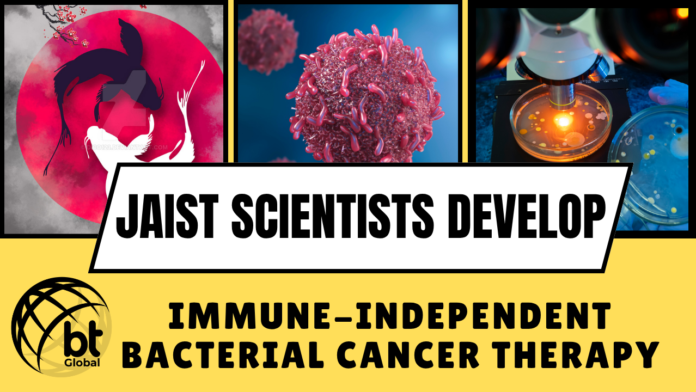Bacterial Cancer Therapy
Imagine being able to do cancer treatment without the use of radiation, chemotherapy, or even your own immune system. That sounds unreal, right, and yet it demonstrates the idea of experimentation. You never know unless you try, and this has been proven yet again by the Japanese scientists who have just made that crazy concept a little bit more feasible.
Researchers at the Japan Advanced Institute of Science and Technology (JAIST), in collaboration with Daiichi Sankyo Co., Ltd. and the University of Tsukuba, have done just that, unveiling a bacterial therapy that kills cancer cells even when the immune system is too weak to help.
The Science Behind the Breakthrough of Cancer Treatment
This therapy works with the coordination of a bacterial duo of Proteus mirabilis, nicknamed A-gyo, and Rhodopseudomonas palustris, known as UN-gyo. Working together, these microbes infiltrate tumors and literally tear them apart from the inside. What’s more interesting is that they don’t need any assistance from the immune cells to do it.
In simple words, while most cancer therapies act positively with a strong immune response, AUN therapy does not depend on the immune strength of the patient and is capable of eradicating the tumors on its own.
In lab studies, these bacteria showed three stunning abilities:
- They can locate and invade tumors with incredible precision.
- They change shape once inside, allowing them to survive and multiply in the tumor’s harsh environment.
- They disrupt the tumor’s blood supply, starving it of nutrients and oxygen until it collapses.
That means no immune activation, no cytokine cascade, and potentially fewer side effects than current immunotherapies, chemotherapy, or radiotherapies.
“This approach rewrites the rules of cancer therapy,” said one of the researchers. “We’re not boosting the immune system, we’re giving bacteria the job directly.”
A 150-Year-Old Dream in action:
The idea of using bacteria for cancer treatment is not new; it was first reported in 1868 by a German physician, Busch, who observed tumor shrinkage in a patient after a bacterial infection. Later, in 1893, Dr. William Coley developed bacteria-based “Coley’s toxin CAR-Tns,” which paved the way for today’s immunotherapies.
But still, nearly all cancer therapies, from checkpoint inhibitors to cells, depend on immune strength. That’s what makes AUN therapy an outstanding approach, as it doesn’t depend on the patient’s immune strength to eradicate cancer.
As Professor Eijiro Miyako from JAIST states, “We are not boosting the immune system, we’re giving bacteria the job directly.”
AUN: Harmony Between Opposites
The name “AUN” comes from a Japanese concept symbolizing balance and duality, two forces working in harmony. In this therapy, A-gyo acts as the destroyer, attacking tumor cells, while UN-gyo regulates the process, keeping it safe and controlled.
This self-balancing relationship ensures precision and an elegant biological partnership that mirrors nature’s own logic of equilibrium.
What’s Next for Research and Careers
Professor Miyako’s team is already preparing to launch a startup to translate this discovery into real-world therapy, with human clinical trials expected within six years.
If successful, this could become the first immune-independent bacterial therapy for cancer, a huge milestone for biotechnology and medical microbiology.
For students and researchers, this discovery isn’t just inspiring; it’s a glimpse into the next era of living medicines. Biotechnology is shifting from chemical drugs to engineered organisms that can sense, adapt, and act inside the human body.
Whether it’s synthetic biology, microbial therapeutics, or precision gene engineering, this field is bursting with opportunity. Biotech hubs across Japan, Singapore, the U.S., the U.K., and India are already investing in microbial therapies and the demand for scientists skilled in CRISPR, microbiome analysis, and biodesign is only growing.
The Bottom Line
Cancer has been a very stubborn hurdle, as it’s almost impossible to cure without harming your own body and having adverse side effects, but this approach might just be the answer to this long-lasting terror of a disease. This time, bacteria might be the answer, the one to outsmart cancer. AUN therapy may still be years from hospitals, but it’s a promise that shows potential.
It’s proof that innovation often begins with a crazy idea and a few determined scientists willing to chase it.
For the next generation of biotech minds, this breakthrough isn’t just a story from Japan. It’s a sign that the future of cancer treatment could come from the most unexpected ally: bacteria.






